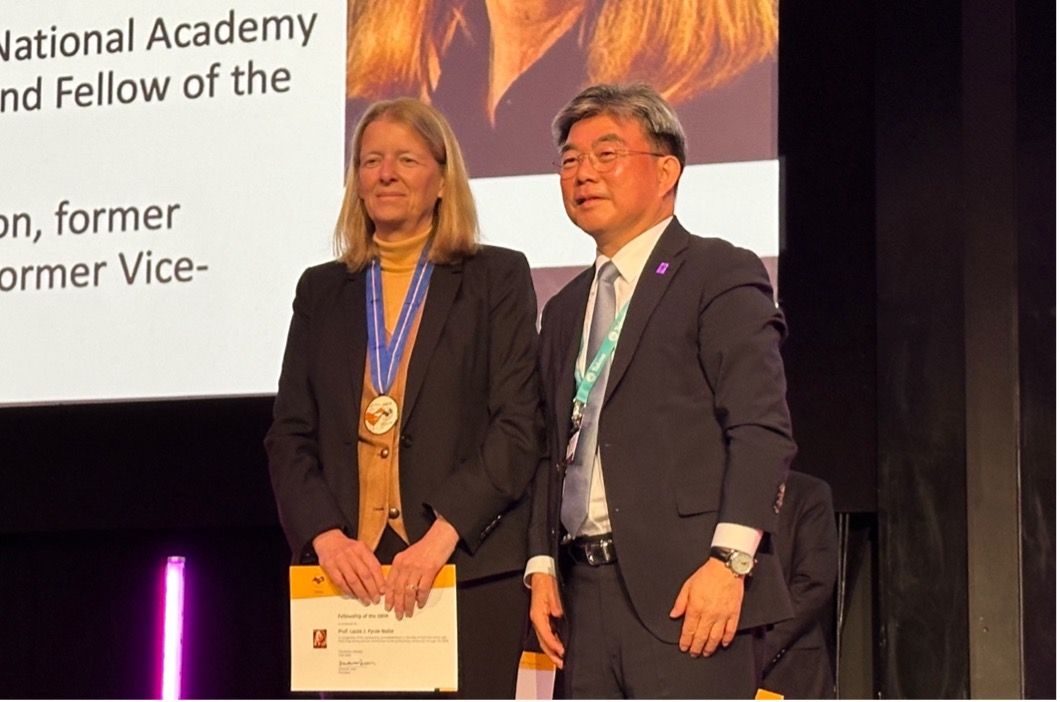Laura Pyrak-Nolte Elected Fellow of the International Society for Rock Mechanics and Rock Engineering
2025-07-03

Professor Laura Pyrak-Nolte was inducted as a Fellow of the International Society of Rock Mechanics and Rock Engineering by President Dr. Seokwon Jeon at the Eurock 2025 Symposium in Trondheim, Norway. (Photo provided by Pyrak-Nolte)
Purdue University's Laura J. Pyrak-Nolte, Distinguished Professor of Physics and Astronomy, has been elected a Fellow of the International Society for Rock Mechanics and Rock Engineering (ISRM). The highest recognition awarded by the global rock mechanics community.
In line with enhancing the recognition of ISRM members' high-level achievements, the ISRM Fellow status is reserved for individuals who have demonstrated outstanding accomplishments in rock mechanics and rock engineering and have made significant contributions to the mission of the ISRM. The title, which represents a lifetime appointment, carries global recognition within the Society and reflects both the recipient's personal achievements and their commitment to advancing the field. The total number of ISRM fellows is less than 0.5% of the membership.
"The ISRM Fellow is the highest honor in the international rock mechanics community," Pyrak-Nolte said. "I am extremely honored to have been selected and to join this elite group of rock mechanicians."
As part of their role, ISRM Fellows serve as a global network of experts who can provide guidance and leadership to the Society. Fellows are also invited to contribute to the ISRM Advisory Forum, which meets every two years to support the Society's mission of promoting safe, efficient, and environmentally responsible engineering practices in rock environments.
At Purdue, Pyrak-Nolte leads the Rock Physics Laboratory, studying how fractures and discontinuities affect rock's strength, stability, and fluid flow. These features can weaken rocks but are vital for resource extraction and contaminant movement. Her goal is to link mechanical, hydraulic, and seismic properties to better predict rock behavior. Her work has broad real-world applications in areas such as:
- Geothermal energy - optimizing access to renewable subsurface resources
- Natural gas production - advancing understanding of extraction processes in fractured formations
- Subsurface storage & sequestration - improving the safety and effectiveness of underground hydrogen and carbon storage
- Nuclear waste disposal - ensuring the long-term security of geological repositories
By studying how fractures form, deform, and interact with their surroundings, Pyrak-Nolte's research offers essential insights for engineering projects that depend on rock stability, from infrastructure development to underground energy storage.
Founded in 1962 in Salzburg, Austria, the International Society for Rock Mechanics and Rock Engineering fosters international collaboration, research excellence, and high professional standards in understanding the complex behavior of rock masses. The induction of ISRM Fellows creates a global group of high-level experts who can provide strong support to the Society's work as needed.
About the Department of Physics and Astronomy at Purdue University
Purdue’s Department of Physics and Astronomy has a rich and long history dating back to 1904. Our faculty and students are exploring nature at all length scales, from the subatomic to the macroscopic and everything in between. With an excellent and diverse community of faculty, postdocs and students who are pushing new scientific frontiers, we offer a dynamic learning environment, an inclusive research community and an engaging network of scholars.
Physics and Astronomy is one of the seven departments within the Purdue University College of Science. World-class research is performed in astrophysics, atomic and molecular optics, accelerator mass spectrometry, biophysics, condensed matter physics, quantum information science, and particle and nuclear physics. Our state-of-the-art facilities are in the Physics Building, but our researchers also engage in interdisciplinary work at Discovery Park District at Purdue, particularly the Birck Nanotechnology Center and the Bindley Bioscience Center. We also participate in global research including at the Large Hadron Collider at CERN, many national laboratories (such as Argonne National Laboratory, Brookhaven National Laboratory, Fermilab, Oak Ridge National Laboratory, the Stanford Linear Accelerator, etc.), the James Webb Space Telescope, and several observatories around the world.
Written by: David Siple, Communications Specialist, Purdue University Department of Physics and Astronomy